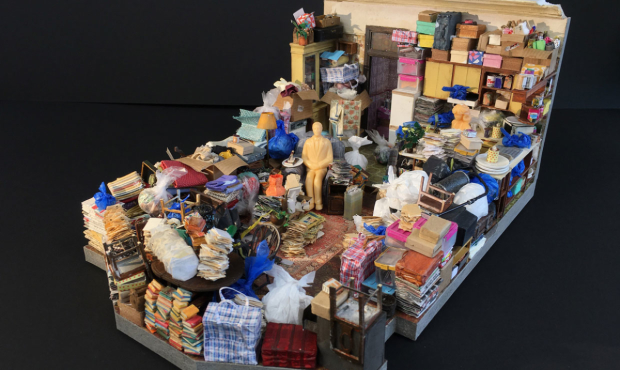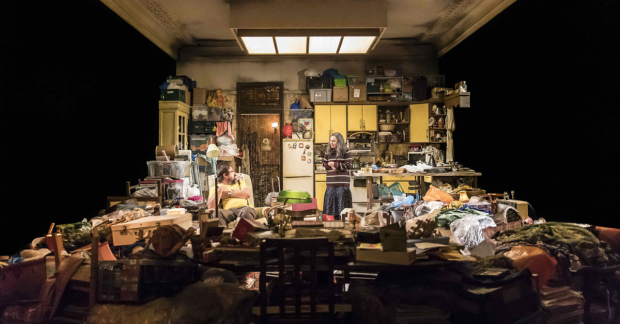Let's Talk About Sets: Max Jones on The House They Grew Up In

The House They Grew Up In presents a brief, but significant period of time in the lives of brother and sister, Daniel (Daniel Ryan) and Peppy (Samantha Spiro). Over the last 30 years, with both their parents having died when they were much younger and also owing to Daniel’s learning differences, the pair have become more and more reclusive, now largely withdrawn from society into the relative safety of their old Victorian terrace home in south east London. In the outside world, modernism and gentrification provide the catalyst for rapid community change, while inside No 23, Peppy is a hoarder and the siblings remain almost frozen in a time capsule, surrounded by relics and memories of the 70 years since their parents bought the house in the '50s. During the play, a significant event causes the outside world to find its way invasively into their home – disturbing their way of life and threatening to further ostracise them from the local community that has left them behind.
Unsurprisingly, Peppy’s hoard has largely been noted as the most significant design detail of the staging. But it wasn’t in fact the starting point for the design process. The play is set over two locations, including the less frequently seen house next door, No. 21.

I usually begin by developing the compositional 'wide shot', rather than any specific detailing of a play, working out all the major scenic 'movements' and then going back to dress in the detail later. You don’t typically view theatre performances extremely close up, as if through a blinkered camera lens. Your periphery vision is always being engaged, even with successful use of focused lighting. With this in mind, I invest a lot of time into the composition of my stage images. I guess it’s where I try to find the art in my work: where possible, developing scenic forms in space until I’m satisfied they have taken on an almost sculptural integrity, beyond the purely functional.
Venues with an interesting or adaptable spatial identity, like the Minerva Theatre at Chichester, exert a huge influence over the outcome of my designs – often more so than the play itself. The Minerva’s 'thrust' stage configuration, with its additional depth available up-stage, allowed me to put the entirety of Peppy’s house and all its contents onto a truck, which we could then 'unexpectedly' track upstage through a gauze wall as part of the location change for the scenes next door. The generous grid height also allowed us to suspend a low ceiling across the full length of the space, complete with period cornice detailing for the interior of No 23. This had two key benefits: firstly to amplify the sense of claustrophobia in Peppy’s and Daniel’s home, but secondly, to assist in concealing from view the flown kitchen ‘island’ which would drop in as part of the scene change into No 21 next door. The base of the kitchen island was designed to be one of two functioning fluorescent light boxes for the interior of No 23, both to provide practical lighting for the scenes below, but also to disguise any suggestion of a scene change until it took place, to audible gasps just before the interval.

© Johan Persson
As for Peppy’s hoard, we now had a truck on which to carry all of her family's life belongings, which could move in their entirety up stage and out of the way with relative ease. It also allowed for ‘split location’ scenes whilst both interiors are in view at the same time.
Nothing in Peppy and Daniel's house has ever been thrown away: boxes, teetering piles of clothes, papers, plastic bags, furniture. There is barely any empty floor space for the characters to move. How might we organise chaos? We arranged all the contents so that it appeared like the interior walls and windows had been removed, leaving the possessions perfectly packed to form a hard edge, as though we had surgically sliced a cross section through the house. This allowed us to present a detailed 'strata' of the family's history to our audience (dead mice included) while again adding a satisfying sculptural integrity to the overall composition of the installation.
Also, once fixed and glued in place, this highly detailed perimeter fence stopped everything else from falling out of the room when it moved.
Universally, designers walk the tightrope between technician and artist. There is a particular kind of alchemy that stage designers must employ to satisfy the varied technical needs of a production, while also remaining true to their own artistic ambition and integrity. This is one of those shows where I hope to have successfully satisfied both.
The House They Grew Up In runs at the Minerva Theatre, Chichester, until 5 August.











